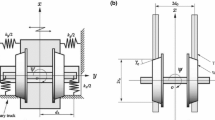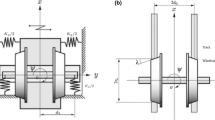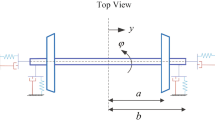Abstract
This paper mainly investigates the dynamics of the non-resonant and near-resonant Hopf–Hopf bifurcations caused by the interaction of the lateral and yaw motion in a simplified railway wheelset model, which involves local and global dynamical scenarios, respectively. This study aims to clarify the resonances due to the wheelset instability. Firstly, the ratio of longitudinal suspension stiffness and the square of natural frequency in yawing direction denoted as the parameter \(k_{22}\) has an important impact on the transitions of distinct Hopf–Hopf bifurcations, and the ratio of the oscillation frequencies \(\omega _1\)/\(\omega _2\) at the Hopf–Hopf singularity point will reduce with the decrease in \(k_{22}\) within a certain range. Secondly, the absence of strong resonance under the non-resonant condition indicates that the operation wheelset will not produce the maximum oscillation amplitude triggered by the resonance point, and several torus solutions arisen from the wheelset are obtained by numerical simulation. Thirdly, five near-resonant Hopf–Hopf bifurcations reveal that the global dynamical scenario becomes much more complex than other cases as \(k_{22}\) decreases. In particular, near the 1:4 resonant Hopf–Hopf interaction occurs when \(\omega _1\)/\(\omega _2\) is close to 1:4, which has the most marked effect on wheelset hunting motions and resonances. Finally, the cyclic bifurcation behaviors under the near-resonant conditions indicate the coexistence of multiple limit cycles, and the loop of equilibria and limit cycles detected between two Hopf bifurcation points reveals that the wheelset will perform a cyclical motion in lateral and yaw direction. These results show that the change in frequency ratio induced by the intersection of the lateral and yaw motion of the unbalanced wheelset will greatly affect the hunting motions and resonances of railway vehicles. Therefore, appropriately increasing the value of \(k_{22}\) is helpful to maintain the vehicle stability.















Similar content being viewed by others
References
Kuznetsov, Y.A.: Elements of Applied Bifurcation Theory, 3rd edn. Springer, New York (2004)
Wiggins, S.: Introduction to Applied Nonlinear Dynamical Systems and Chaos. Springer, Berlin (1990)
Dong, H., Zeng, J., Xie, J.H., et al.: Bifurcation\(\backslash \)instability forms of high speed railway vehicles. Sci. China Technol. Sci. 56(7), 1685–1696 (2013)
Huang, C.H., Zeng, J., Liang, S.L.: Influence of system parameters on the stability limit of the undisturbed motion of a motor bogie. Proc. Inst. Mech. Eng. Part F J. Rail Rapid Transit. 228(5), 522–534 (2014)
Huang, C.H., Zeng, J.: Suppression of the flexible carbody resonance due to bogie instability by using a DVA suspended on the bogie frame. Veh. Syst. Dyn. (2021). https://doi.org/10.1080/00423114.2021.1930071
Revel, G., Alonso, D.M., Moiola, J.L.: Numerical semi-global analysis of a 1:2 resonant Hopf–Hopf bifurcation. Physica D 247, 40–53 (2013)
Revel, G., Alonso, D.M., Moiola, J.L.: Interactions between oscillatory modes near a 2:3 resonant Hopf-Hopf bifurcation. Chaos 20, 043106 (2010)
Revel, G., Alonso, D.M., Moiola, J.L.: A gallery of oscillations in a resonant electric circuit: Hopf–Hopf and fold-flip interactions. Int. J. Bifurc. Chaos Appl. Sci. Eng. 18, 481 (2008)
Yabuno, H., Okamoto, T., Aoshima, N.: Stabilization control for the hunting motion of a railway wheelset. Veh. Syst. Dyn. 35, 41–55 (2001)
Yabuno, H., Okamoto, T., Aoshima, N.: Effect of lateral linear stiffness on nonlinear characteristics of hunting motion of a railway wheelset. Meccanica 37(6), 555–568 (2002)
Ge, P., Wei, X., Liu, J., et al.: Bifurcation of a modified railway wheelset model with nonlinear equivalent conicity and wheelCrail force. Nonlinear Dyn. 102(1), 79–100 (2020)
Cheng, L.F., Wei, X.K., Cao, H.J.: Two-parameter bifurcation analysis of limit cycles of a simplified railway wheelset model. Nonlinear Dyn. 93, 2415–2431 (2018)
True, H.: Dynamics of a rolling wheelset. Appl. Mech. Rev. 46, 438–444 (1993)
Wickens, A.H.: The dynamics stability of a simplified four-wheel railway vehicle having profiled wheels. Int. J. Solids Struct. 1, 385–406 (1965)
Xu, G., Troger, H., Steindl, A.: Global analysis of the loss of stability of a special railway body. In: Schiehlen, W. (ed.) Nonlinear Dynamics in Engineering Systems, pp. 345–352. Springer, Berlin (1990)
Wen, G.L., Xu, H.D., Xie, J.H.: Controlling Hopf–Hopf interaction bifurcations of a two-degree-of-freedom self-excited system with dry friction. Nonlinear Dyn. 64, 49–57 (2011)
Parks, P.C.: A new proof of Hermite’s stability criterion and a generalization of Orlando’s formula. Int. J. Control 26(2), 197–206 (1977)
Chow, S., Li, C., Wang, D.: Normal Forms and Bifurcation of Planar Vector Fields. Cambridge University Press, Cambridge (1994)
Dhooge, A., Govaerts, W., Kuznetsov, Y.A.: MATCONT: a MATLAB package for numerical bifurcation analysis of ODEs. ACM Trans. Math. Softw. 37(9), 141–164 (2003)
Balanov, A.G., Janson, N.B., Schöll, E.: Delayed feedback control of chaos: bifurcation analysis. Phys. Rev. E 71, 016222-1, 9 (2005)
Acknowledgements
This work is supported by the Fundamental Research Funds for the Central Universities under Project No. 2021QY005, the State Key Laboratory of Traction Power, Southwest Jiaotong University under Project No. TPL2001, the National Natural Science Foundation of China (Grant Number 51905454), and Independent R&D Project of the State Key Laboratory of Traction Power (Grant Number 2019TPL_T22).
Author information
Authors and Affiliations
Corresponding author
Ethics declarations
Conflict of interest
The authors declare that they have no conflict of interest.
Additional information
Publisher's Note
Springer Nature remains neutral with regard to jurisdictional claims in published maps and institutional affiliations.
Rights and permissions
About this article
Cite this article
Guo, P., Huang, C., Zeng, J. et al. Hopf–Hopf bifurcation analysis based on resonance and non-resonance in a simplified railway wheelset model. Nonlinear Dyn 108, 1197–1215 (2022). https://doi.org/10.1007/s11071-022-07274-0
Received:
Accepted:
Published:
Issue Date:
DOI: https://doi.org/10.1007/s11071-022-07274-0




